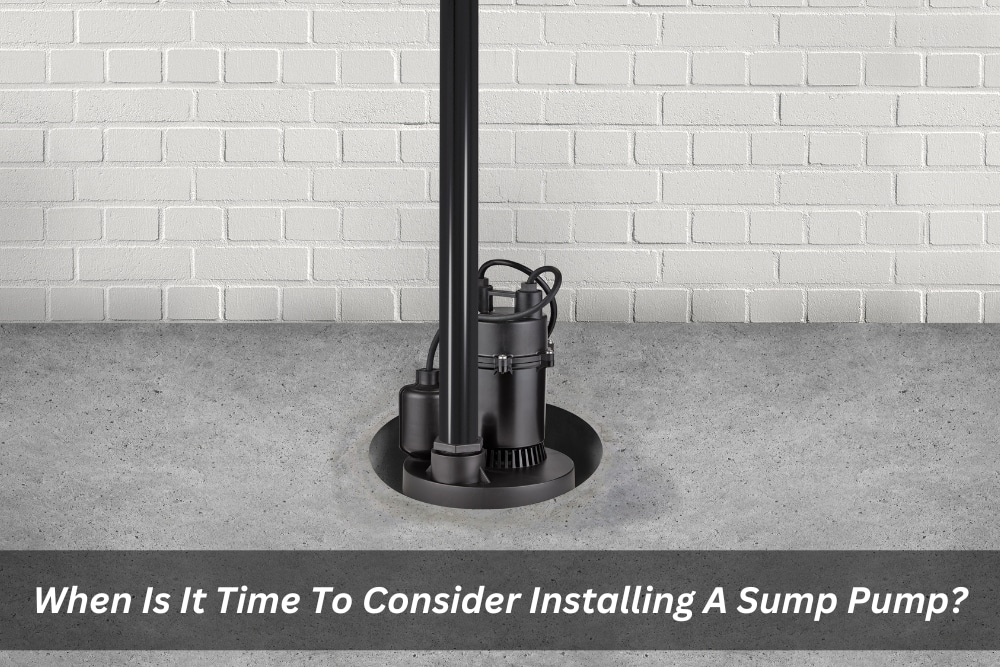Living in a home with a basement comes with its perks, but it also brings along a specific set of challenges. One of the most common issues that homeowners with basements face is water intrusion. Whether it’s due to heavy rain, a high water table, or poor drainage, water in the basement can lead to a host of problems, from property damage to health hazards. To mitigate this risk, many homeowners opt for the installation of a sump pump. But when is the right time to consider this investment? Let’s explore some key signs that indicate it might be time to install a sump pump in your home.
Are you experiencing any of these signs?
Before diving into the installation process and other details, it’s essential to understand the signs that may indicate the need for a sump pump in your home.
- Frequent basement flooding: If you find your basement frequently inundated with water, it’s a clear sign that a sump pump could be beneficial. Whether it’s due to heavy rainfall or high groundwater levels, repeated basement flooding can lead to significant structural damage and mould growth.
- Persistent dampness: Even if your basement doesn’t flood completely, persistent dampness can be problematic. It can promote mould and mildew growth and cause damage to your possessions. A sump pump can help keep your basement dry.
- Visible cracks or water stains: If you notice cracks in your basement walls or water stains on the walls or floor, this could be a sign of water seepage. Addressing the issue early with a sump pump can prevent more extensive damage.
- Unpleasant odours: A musty, damp smell in your basement is often an indication of excess moisture, which can be mitigated with a sump pump.
- High water table: If you live in an area with a high water table, your risk of basement flooding is elevated. A sump pump is a valuable addition to your home in such locations.
- Previous flooding incidents: If you’ve experienced basement flooding in the past, it’s a clear sign that your property is vulnerable to water damage, and a sump pump is a proactive solution to prevent future occurrences.
What are the benefits of installing a sump pump?
Investing in a sump pump comes with several advantages that go beyond just preventing basement flooding. Consider the following benefits when contemplating the installation of a sump pump:
- Prevent basement flooding
A sump pump effectively removes excess water from the basement. It prevents flooding and the subsequent damage it can cause to your property and belongings.
- Protect your belongings from water damage
By keeping your basement dry, a sump pump safeguards your valuable possessions, such as furniture, electronics, and personal belongings, from water-related harm.
- Reduce the risk of mold and mildew growth
Excessive moisture in the basement can create an ideal environment for mould and mildew to flourish. A sump pump helps maintain a dry environment, inhibiting the growth of these harmful substances and improving the overall air quality in your home.
- Increase the value of your home
The presence of a properly functioning sump pump can add to the value of your property, especially in areas prone to water-related issues. Potential buyers often consider the presence of a sump pump as a proactive measure against potential water damage, making your home a more attractive investment.
How to choose the right sump pump for your needs
Selecting the right sump pump is crucial to ensure its effectiveness in safeguarding your basement from water damage. Consider the following factors when choosing a sump pump:
- The size of your basement will determine the capacity and power requirements of the sump pump. Larger basements or those with frequent water intrusion may require a more powerful pump to handle the volume of water effectively.
- There are different types of sump pumps, including submersible and pedestal pumps, each with its own set of advantages and limitations. Evaluate your basement’s specific needs and consult a professional to determine the most suitable type for your situation.
- Look for features such as a reliable float switch, a sturdy and corrosion-resistant construction, and a battery backup system for continued operation during power outages. Basically, opting for a pump with these additional features can provide you with extra peace of mind.
How to install a sump pump
While installing a sump pump can be a complex process, following these essential steps can help ensure a successful installation:
- Select a location in your basement where water tends to accumulate the most. This area should be close to a power source and away from any obstructions that might interfere with the pump’s operation.
- Dig a pit in the chosen location to accommodate the sump pump. Also, ensure that the pit is deep enough to accommodate the pump and allow space for water to collect without overflowing.
- Carefully install the sump pump in the designated pit, following the manufacturer’s instructions. In addition, make sure the pump is securely positioned and properly aligned for efficient water removal.
- Connect the pump to a reliable power source, ensuring that the electrical connections are secure and comply with safety standards. Consider using a ground fault circuit interrupter (GFCI) to minimise the risk of electrical hazards.
- After installation, test the sump pump to ensure it is functioning correctly. Pour water into the pit to activate the pump and verify that it effectively removes water from the pit without any issues.
How to maintain a sump pump
Regular maintenance is essential to keep your sump pump in optimal working condition and prevent potential failures. Follow these maintenance tips to prolong the life of your sump pump:
- Remove any debris or sediment that may accumulate in the sump pit to prevent clogs and ensure smooth operation. Regular cleaning helps maintain the efficiency of the pump and prevents potential blockages.
- Periodically check the pump for any signs of damage, including cracks, rust, or other forms of deterioration. Promptly address any issues to prevent further damage and ensure the pump’s continued functionality.
- Conduct regular tests to verify that the sump pump is functioning as intended. Simulate a water intrusion scenario to ensure that the pump activates automatically and effectively removes water from the pit.
When should you replace your sump pump?
While sump pumps are designed to be durable, they have a limited lifespan. Consider the following indicators that signal the need for a sump pump replacement:
On average, sump pumps can operate efficiently for 7-10 years before experiencing issues or reduced performance. If your sump pump is approaching this age range, it’s advisable to consider a replacement to maintain your basement’s protection.
Furthermore, as sump pumps age, their efficiency and reliability may decline, increasing the risk of failure during critical moments. Proactively replacing an older sump pump can prevent unexpected malfunctions and potential water damage to your basement.
Additionally, an excessively active sump pump may indicate that it’s struggling to keep up with the volume of water entering the sump pit. This constant strain can lead to premature wear and reduced effectiveness, necessitating a replacement to ensure adequate protection.
Conclusion
Installing a sump pump can be a crucial step in safeguarding your home from the damaging effects of water intrusion. By recognising the signs that indicate the need for a sump pump, understanding its benefits, and familiarising yourself with the installation and maintenance process, you can effectively protect your basement and valuable possessions from the detrimental consequences of excess water. Regularly monitoring your sump pump’s performance and promptly addressing any issues can ensure that your basement remains dry and secure. It also provides you with peace of mind and preserving the integrity of your home for years to come.
Suppose you’ve noticed any of the warning signs mentioned in this article, such as persistent water accumulation in your basement, frequent flooding, or cracks in your foundation. In that case, it’s time to take proactive measures to protect your home. Apex Plumbing Solution is here to assist you in safeguarding your property from the risks associated with water intrusion. Our experienced team can help you choose the right sump pump for your specific needs. We’ll ensure proper installation and provide guidance on effective maintenance practices. Don’t wait until it’s too late—contact Apex Plumbing Solution today and secure your home from the damaging effects of water.


